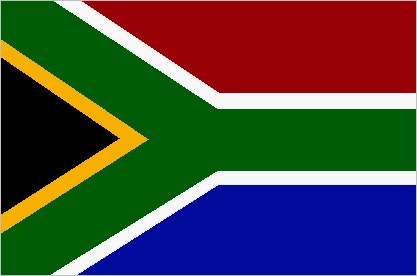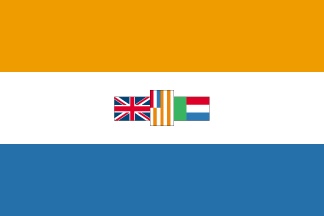South Africa, flag of
Flag History

national flag consisting of a horizontally oriented Y-shape (known in heraldry as a pall) in green, with yellow (gold) and white borders, separating sections of red and blue and a black hoist triangle. The flag's width-to-length ratio is 2 to 3.
 The two major European populations in South Africa, the Dutch (now Afrikaners (Afrikaner)) and the English, brought flags whose use persisted until 1994. The orange-white-blue tricolour of the 17th-century Netherlands was the basis for the national flag officially hoisted on May 31, 1928, by the Union of South Africa. The British Union Jack (United Kingdom, flag of the) and the flags of the Transvaal and Orange Free State were added to the centre of that flag. Absent was any symbol for the overwhelming majority of the population, black Africans, or for the country's Coloured (mixed-race) and Indian inhabitants.
The two major European populations in South Africa, the Dutch (now Afrikaners (Afrikaner)) and the English, brought flags whose use persisted until 1994. The orange-white-blue tricolour of the 17th-century Netherlands was the basis for the national flag officially hoisted on May 31, 1928, by the Union of South Africa. The British Union Jack (United Kingdom, flag of the) and the flags of the Transvaal and Orange Free State were added to the centre of that flag. Absent was any symbol for the overwhelming majority of the population, black Africans, or for the country's Coloured (mixed-race) and Indian inhabitants.The end of the apartheid era was marked by the universal-suffrage democratic elections of April 1994, which resulted in a strong victory for supporters of the African National Congress (ANC). Many whites had feared that the black-green-yellow horizontal tricolour of the ANC, representing black Africans, the land, and mineral wealth, would be made the national flag. Instead, the new flag hoisted on April 27 was a compromise in design and colours intended to represent and reassure all segments of the population. Designed by state herald Frederick Brownell, it has as its principal symbol a Y-shape symbolizing the “converging of paths…merging history and present political realities” into a common determination to create a united and prosperous future.
The new flag is unique in combining six colours; traditional flags had two or three colours, and some modern flags four or five colours. The flag colours could be related to various groups—red-white-blue for English people and Afrikaners, green for Muslims, black-green-yellow for ANC supporters, red-white-black-green-yellow for Zulus (Zulu), and so on. Intentionally, however, and in contrast to most other modern national flags, the new design for South Africa explicitly avoids any specific symbolic association for the colours, as this was considered “treading on dangerous ground.” The flag, intended as temporary, was confirmed by the 1996 constitution as permanent, based on the overwhelming popular support it had gained and on the optimistic spirit of South Africans regarding their national future.
- Hamdi Bey, Osman
- Hamdānī, al-
- Hamelin, Ferdinand Alphonse
- Hameln
- Hamer, Fannie Lou
- Hamerling, Robert
- Hamersley Range
- Hamgyŏng Mountains
- Hamhŭng
- Hami
- Hamid Dynasty
- Hamid Karzai
- Hamilcar Barca
- Hamill, Dorothy
- Hamilton
- Hamilton, Alexander
- Hamilton, Alice
- Hamilton, Andrew
- Hamilton College
- Hamilton, Edith
- Hamilton, Emma, Lady
- Hamilton Fish
- Hamilton, Gavin
- Hamilton, Hamish
- Hamilton Hume